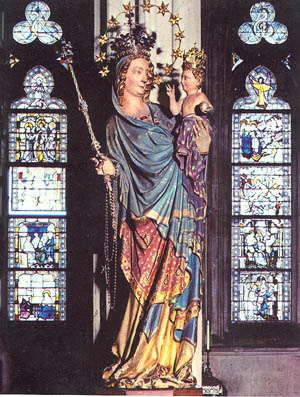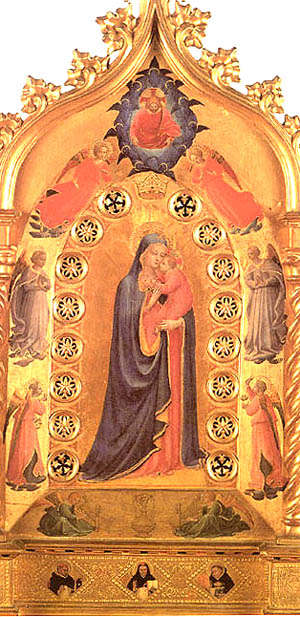 |
Feast Days of Our Lady
The Divine Maternity of Our Lady
October 11
Prof. Plinio Corrêa de Oliveira
Our Lady corresponded to all the extraordinary graces she received, which makes her a unique creature in the universe and in the economy of salvation. The starting point of all those graces, however, lies in the fact that she was the Mother of Our Lord Jesus Christ, which means, according to Catholic doctrine, that she is the Mother of God.

Our Lady and the Christ Child, Cathedral of Milan |
In the work of God everything is nuanced and hierarchical. The revolutionary spirit loves to simplify everything. The counter-revolutionary spirit, on the contrary, loves the nuances in Creation and in the Catholic Church. When a counter-revolutionary sees something difficult to understand, something that apparently contradicts the rule he knows, he loves that point, because he knows that in the work of God and in the Catholic Church nothing is contradictory. When something appears to contradict the order we know, it is because often it conceals something more beautiful than the rule, which God permits in order to reveal to us another order of reality.
The waves that wash the sands of a beach leave a smooth and shining mirror of wet sand between one wave and the next. A child who admires the beauty and uniformity of that mirror may be surprised to find an air bubble here and there that appears on its glassy surface. He may think it strange, and certainly he does not know why it is there. But when the wave recedes, if he goes to the spot and quickly digs a bit, he realizes that the bubble marks the spot where a clam is living. Something strange in appearance is explained after a proper investigation, and it opens the mind to another order of reality that is not visible at first glance.
What affirmation can appear more absurd to a Cartesian and revolutionary spirit than that of the Mother of God? For a person unfamiliar with Catholic doctrine it would appear absurd that God, an eternal and pure spirit, has a Mother. The complication intensifies when he realizes that this Mother is a human being. How can a finite creature generate Infinity? How can someone set in mutable time engender the Eternal? In the affirmation that Our Lady is Mother of God there are many apparent contradictions. There is, however, a profound and superior harmony beneath the surface for one who seeks to understand.
Why did God make the hypostatic union with the human nature instead of the angelic nature? Would it not have been more perfect to do the latter? No, by establishing His hypostatic union with a less elevated degree in the hierarchy of Creation, God did something more wondrous than if He had established it with the Angels.
In fact, if He would have chosen to unite himself with the Angels, He would have dignified only the angelic nature. Instead, by uniting with the human nature, He dignified all Creation. For since man has a soul, he participates in the spiritual dignity of the Angels, and since he has a body he also participates in the material kingdoms – animal, vegetal, and mineral. So, by making the hypostatic union with the human rather than the angelic nature, God dignified all of the created universe. The apparent incongruence reveals a more beautiful and wise decision of God.
The Second Person of the Divine Trinity decided to become incarnate taking on human nature. But He desired to depend on the consent of the one who would give Him this nature. Doing this, He placed Our Lady in the most privileged place in the created hierarchy, because with her acceptance, the whole universe would be glorified. She accepted, and for that reason, she became the universal mediatrix between God and the rest of Creation. She became the necessary link of alliance between rational creatures – Angels and men – and God. It is for this reason that she is properly called Queen of Angels, Queen of all Men, Queen of the Universe, and Queen of Heaven and Earth.

Madonna della Stella, by Fra Angelico |
Once a Catholic with progressivist tendencies told me that the only thing that mattered to him about Our Lady was that she is Mother of God, nothing else. I thought: “Something is wrong here.”
It was his progressivist and revolutionary simplification. Without a doubt Mother of God is the most important title of Our Lady. But since from all eternity God had the intention to make her Mother of God, she was prepared as His masterpiece of Creation. She was, therefore, the most perfect creature ever to exist, noble enough to give Him the human nature He received from her. To disregard all the other qualities, virtues and titles of Our Lady is to simplify things in a wrong way.
A tree is not only its trunk or its roots. It is an ensemble composed of roots, trunk, branches, leaves, flowers and fruits. In Our Lady we should consider each one of the different aspects that make up her inestimable personality. The Catholic spirit venerates Our Lady principally under the title of Mother of God, but it also venerates the roots, branches, leaves, flowers and fruits that grow out of this most essential trunk. That is, we should venerate her under the countless different invocations she rightly has, each one of which reflects a different aspect of her mission, even though all of them flow from her Divine Maternity.
An important point that applies especially to us is that since she is the Mother of God, she is also the Mother of all men and, therefore, she is Our Mother. One of the most precious graces we can receive regarding devotion to Our Lady is when she condescends to establish a relation that is truly maternal with us. This can happen in a thousand different ways.
Sometimes she reveals herself as Our Mother when she saves us from a danger in a way that becomes unforgettable. Other times, she forgives some particularly unpardonable fault, exercising a goodness that only a mother has. Nothing merited the pardon, nothing should have attenuated its punishment, we deserved the wrath of God. However, since she is a mother, she entered with her sovereign power and indulged us as only a mother can do. With a tender smile she wiped away the bad past, and made it forgotten.
Our Lady concedes such graces in a manner that often they remain manifest in the soul like a blaze of fire, a fire that comes from Heaven and the Holy Ghost, not an earthly fire, and still less the infernal fire. It gives birth in our souls to the conviction that we can have recourse to her in any circumstance, even the most indefensible ones, and that she will forgive us again, because she opens to us a door of mercy that no one can close.
We who fight for the defense of the Holy Church in the present day crisis and for the Reign of Mary as a new Christendom to come, receive an unlimited credit of mercy from Our Lady. It would seem that the passage of the Apocalypse could be applied to the mercy of Our Lady for us:
“I have given before thee an open door, which no man can shut: because thou hast a little strength, and hast kept My word, and hast not denied My name” (Apoc 3:8).
I think that it is more than legitimate to apply these words to our relationship with the Immaculate Heart of Mary.


  | | Prof. Plinio Corrêa de Oliveira | |
The Saint of the Day features highlights from the lives of saints based on comments made by the late Prof. Plinio Corrêa de Oliveira. Following the example of St. John Bosco who used to make similar talks for the boys of his College, each evening it was Prof. Plinio's custom to make a short commentary on the lives of the next day's saint in a meeting for youth in order to encourage them in the practice of virtue and love for the Catholic Church. TIA thought that its readers could profit from these valuable commentaries.
The texts of both the biographical data and the comments come from personal notes taken by Atila S. Guimarães from 1964 to 1995. Given the fact that the source is a personal notebook, it is possible that at times the biographic notes transcribed here will not rigorously follow the original text read by Prof. Plinio. The commentaries have also been adapted and translated for TIA's site.
|
Saint of the Day | Home | Books | CDs | Search | Contact Us | Donate

© 2002- Tradition in Action, Inc. All Rights Reserved
|
 |
|